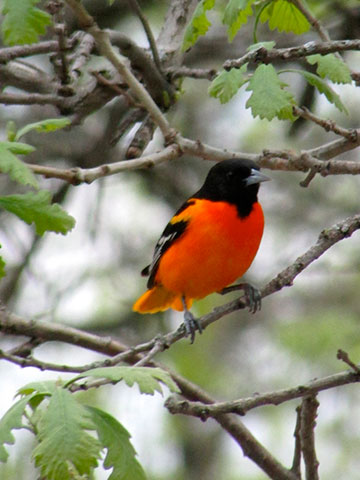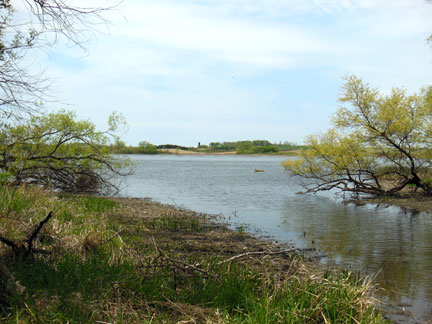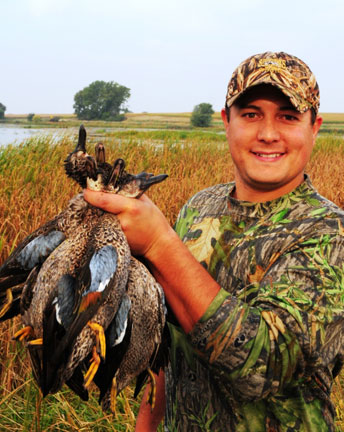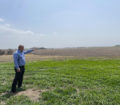By Steve Weisman
When my granddaughter’s teacher approached me about helping out at the Estherville Lincoln Central 5th grade Field Day at the Iowa Lakeside Lab this past Friday, I jumped at the chance. After all, that’s what retired grandpas are supposed to do, right?
Since I was going to be a leader (guide leading a group from one station to another), I met with Jane Shuttleworth, educational coordinator for the lab, for a tour. I certainly didn’t want to get on the wrong trail and have the students and myself become lost!
First time visit
Right off, and I am not proud of this, I must admit that this was the first time I had been on the Lakeside Lab grounds in the 36 years I have lived in the area. As Jane said, however, better late than never! During our walk of the grounds, Jane and I went to each of the four learning stations, and I was impressed by what I observed. What a wonderful outdoor lab (and indoor facilities) this is. During Jane’s session on Friday, she told the 5th graders that next week college students were coming and instead of just being there for three hours, they were going to be at the lab (living there) for four weeks. That definitely impressed the 5th graders!
With the class divided into small groups of 12 students and their teacher, each of the sessions was an interactive one. Jenna Pollock, the Emmet County Naturalist, led the students on a meandering trail, where they listened to nature’s sounds and picked out telltale signs of wildlife activity. Of course, they all got to see the huge eagle’s nest on the northeast corner of Little Millers Bay. Sure enough one of the adult eagles landed as we observed the nest.
Gary Phillips, professor at Iowa Lakes Community College, talked to the students about life in lakes. Even with the cold water temperatures and late spring, Gary was able to show the students some plant and aquatic life that he had collected in water-filled jars.
Jane Shuttleworth took the students to the Waitt Lab, where they all got to use a microscope and see what is in the water in Little Miller’s Bay. Students enjoyed and were amazed at what this life looked like under the microscope.
Dr. Bob Gordon, former teacher at Estherville, headed the fourth station. His topic was TWIGology: how a tree grows. By the time the 30-minute session was over, all students knew the different ways to determine the age of a tree, a branch and a twig.
School visits like this one are made possible thanks to a grant from the Friends of Lakeside Lab, Lakeside’s support group. The purpose of their school grant program is to provide hands-on, nature based learning opportunities for students. Their website is www.friendsoflakesidelab.org.
About the Lakeside Lab
The Lakeside Lab offers so much for the general public: academic programs, university classes and a wide range of public programs. Here are a few of their summer programs.
• Lakeside Treasure Hike (June-October. A self-guided nature exploration and tour of Lakeside ground. Visitors can pick up a treasure map at the Lakeside Main Parking Lot and go exploring for hidden creatures and secret messages.
• Wild Wednesdays. Free fun, family oriented programs each Wednesday evening at 7 p.m. at the Wait Lab. The first session is June 18 and is entitled “Wonder Woman and the Fish.” The final session will be on August 6.
• Faculty lecture series. Held on Tuesday evenings at 7:30 at the Waitt Lab.
• Coffee and Grounds. Held on Tuesday mornings at 8:30, attendees meet at the Waitt Lab to work hard and learn about native ecosystems while restoring prairie and oak savanna at Lakeside. Then relax over coffee and rolls!
You can go online to their website at www.continuetolearn.uiowa.edu/lakesidelab or you can call 712-337-3669 to learn more.
A little history
For those in the area that have never been to the Lakeside Lab, here is a little history taken from the website. Dr. Thomas Macbride and colleagues at the University of Iowa founded the Lakeside Lab in 1909 for “the study of nature in nature.” Ownership was held at first by a private stock company, the Lakeside Laboratory Association. In 1936 the Association deeded the station to the state of Iowa, “to be held in trust for the accommodation, promotion, support and maintenance of scientific studies and research.”
A major construction program took place in the mid 1930s, when the Civilian Conservation Corps built five stone laboratories, four student cabins, a bathhouse, and other amenities. Additional buildings were added in the 1960s and 70s. The Waitt Building, opened in 1998, provided a modern water quality laboratory, additional classrooms, and staff offices.
In 2006 Lakeside was designated a Regents Resource Center, expanding both its audience and its mission. Today the Lab is a place where people of all ages and backgrounds can “study nature in nature.”
Lakeside Lab, which is owned by the state of Iowa and operated through the Board of Regents has a twofold mission: 1) to provide science classes and research opportunities for university students, and 2) to offer public programs and provide services through the state universities.
Lakeside’s 147-acre campus is located on scenic West Okoboji Lake, on Little Miller’s Bay. The bay and adjacent natural areas are used as outdoor classrooms for Lakeside’s university courses and public programs. The campus is open year round, and visitors are welcome to visit during daylight hours.
Grounds and natural
Lakeside occupies 147 acres, including the entire shoreline of Little Miller’s Bay of West Okoboji Lake. Most of the campus is natural land. The campus can be divided into three sections: 1) the Ecological Studies Campus, 2) the Residential Campus, and 3) the Teaching Campus.
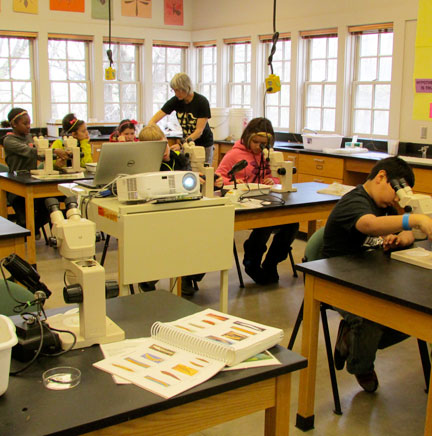
Jane Shuttleworth, educational coordinator for the Lakeside Lab helps students “see” what’s in the water at Little Miller’s Bay through their microscopes.
• The Ecological Studies Campus occupies more than three-fourths of the land mass at Lakeside, including the entire northern portion. The northwest part, long called “The North 40” by faculty and staff, is being restored to prairie. Another 23 acres to the immediate east is reconstructed prairie, planted in 2002-03. A second-growth woods of box elder and other trees separates these areas from West Okoboji Lake and the Residential Campus to the south.
• The Residential Campus includes the Lakeside Office, the Facility Manager’s Residence, faculty and student housing, the bathhouse, the Mess Hall, and adjacent lawns. A ravine shaded by burr oaks and other trees separates this part of Lakeside from the Teaching Campus to the south.
• The Teaching Campus features a high knoll that slopes down to Little Miller’s Bay. The Waitt Lab, Mahan Hall, the Library, all laboratories, Tamisiea Cottage, and Main Cottage are located here. The landscape is very naturalistic, with prairie and meadows occupying the higher ground and oak woods/savanna growing near the lake. Native plant gardens are being developed near the Waitt Lab.
It was definitely a fun day at the Iowa Lakeside Lab. It’s definitely worth putting on your “to-do” list of things to visit this summer.
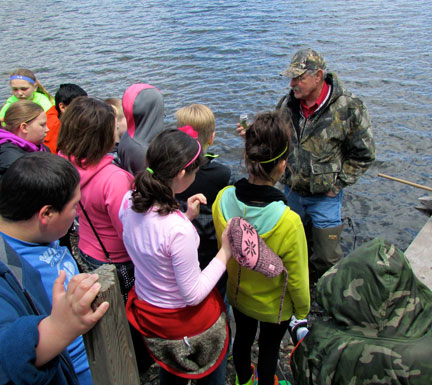
Gary Phillips, professor at Iowa Lakes Community College, discusses life in the water with Estherville Lincoln Central 5th graders.

